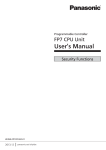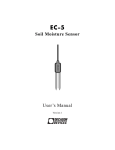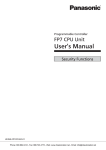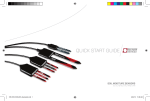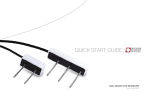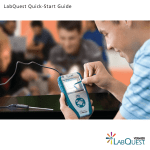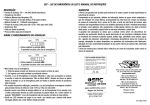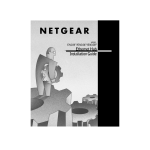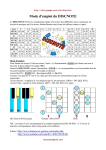Download Application Note - Decagon Devices, Inc.
Transcript
Application Note Frequently Asked Questions about the Decagon’s Soil Moisture Probes and Accessories From this point forward, all of Decagon’s soil moisture sensors will be referred to as ECH2O probes. General 1. How does the ECH2O probe measure volumetric water content (VWC)? The ECH2O probes use capacitance to measure the dielectric permittivity of the surrounding medium. The volume of water in the total volume of soil most heavily influences the dielectric permittivity of the soil because the dielectric of water (80) is much greater than the other constituents of the soil (mineral soil, 4; organic matter, 4; air, 1). Thus, when the amount of water changes in the soil, the ECH2O probe will measure a change in capacitance (from the change in dielectric permittivity) that can be directly correlated with a change in water content. Circuitry inside the ECH2O probe changes the capacitance measurement into a proportional millivolt output. 2. What is the difference between volumetric water content (VWC) and gravimetric water content (GWC)? Gravimetric water content is the weight of soil water per unit weight of dry soil. Volumetric water content is the volume of soil water per unit of total volume. Volumetric and gravimetric water content are related by the bulk density of the soil. Gravimetric water content is the most easily measured, requiring only a glass jar with a lid, an accurate scale, and an oven. Indeed, while GWC may be more easily obtained and more intuitive, the output of most soil water content sensors (including ECH2O probes) is correlated with VWC. One common calibration error is to relate probe output with GWC. 3. Does the probe read water content at a certain point on the sensor, or does it average over the entire length? The probe averages the volumetric water content over the entire length of the probe. The volume of influence depends on which Decagon sensor that 800-755-2751 you are using; the EC-5, EC-TM, and 5TE have a volume of influence of 0.3 L while the 10HS sensor has a volume of influence of 1 L. 4. Where is the probe the most sensitive? The electromagnetic field produced by the probe decreases with distance from the probe surface. 5. How long will the ECH2O probes last in the field? ECH2O probes should last at least 3 years in the field. In fact, we expect them to last much longer than that. Since we began selling the probes in the spring of 2001, we have been constantly improving the probe to increase their longevity in the field. The sensors utilize a chemical on the circuit board that creates a physical bond between two plastics to decrease the chance of water entering the sensor circuitry. The sensor also utilizes a rodent-repellant cable additive to prevent rodent damage. Ongoing testing has shown these new probes to be exceptionally robust, even in extreme conditions. We continue to explore opportunities to increase the field life of the sensors. 6. What is the difference between the different sensor models? All of the ECH2O sensors measure water content using a dielectric measurement; the EC-5, EC-TM, 5TE, and 10HS use a measurement frequency at 70 MHz, compared to the EC-10 and EC-20 sensors at about 10 MHz. Because of this increased measurement frequency, the 70 MHz sensors has low sensitivity to differences in electrical conductivity (EC, tested to 8 dS/m) and soil texture. In addition to VWC, the 5TE also measures bulk electrical conductivity (EC), and temperature. The EC-TM measures temperature in addition to VWC. The EC-5, 5TE, and EC-TM all have prongs with a length of 5cm. The 10HS has prongs of 10cm length. For more detailed comparisons and specifications, please visit our specs page. www.decagon.com [email protected] Application Note 7. In what case would I choose the EC-5 over the 10HS? Any time where large sampling volume is not essential. 8. Is the ECH2O sensor itself exposed to the soil? No. The copper traces used to measure water content are sealed between two pieces of epoxy-impregnated fiberglass (circuit board material). The EM field generated by the traces travels through the fiberglass and into the soil surrounding the probe. Measurement and Applications 1. Can I measure the moisture content of grain using the ECH2O probe? We have not conducted any studies on this application. There may be limits on the accuracy of the ECH2O because of the air gaps between the probe and the grain. It may be useful to use an evaluation ECH2O unit to determine whether the ECH2O probe could be used in your application. 2. How would the ECH2O probe function in a lowdensity medium like Perlite? We recommend using an EC-5, the EC-TM or 5TE in low density media like Perlite. From our testing so far, these probes perform very well in low density media. A factory calibration for perlite can be found in the user’s manual. 3. Can the ECH2O probe measure the water content of organic matter and compost? We would also recommend the EC-5, EC-TM, or 5TE in these applications. Because they have a forked design instead of a blade, they can measure over a much larger range of water contents (all the way up to 100% volumetric water content (VWC) with the right calibration. The maximum temperature that the soils can function is 60 degrees C so compost measurements are only possible below this temperature. We are currently conducting tests to make compost measurement more reliable. 4. How does the probe respond to high soil moisture content? The EC-5, EC-TM, or the 5TE are a good option to measure soils or soilless substrates with high VWC 800-755-2751 because its output does not fall off when soil reaches saturation. The 10HS is accurate at high soil moisture contents, but not at high soilless substrate moisture contents (>56%). The EC-10 and -20 tend to lose some resolution near saturation. However, they should still be able to differentiate between different moisture contents even at these high water contents. 5. Can the ECH2O probe be used in soils at a depth between 0 - 5 cm? ECH2O probes can be used effectively at shallow depths, but temperature fluctuations are a consideration. Inherent in ECH2O measurements, as with TDR and other capacitance probes, is a temperature dependence of 0.003 m 3 m -3 per degree C maximum, with typical of ~0.001 m3 m-3 °C -1. Obviously, temperature fluctuations near the surface would be an issue in these measurements. We have worked on a method of removing some of the temperature dependence. Still, these measurements should be approached with considerable caution. 6. What is the effect of temperature variation on ECH2O probe output? Recently, several studies have shown the temperature sensitivity of probes that measure the dielectric constant of soil. It is well known that the dielectric of water changes with temperature, but theories to explain temperature sensitivity of soil dielectric are relatively new. In our tests, the ECH2O probe has a maximum temperature sensitivity of ~0.003 m3 m-3 per °C, similar to other sensors we tested and to data found in the literature. Details of this study can be found in the application note Response of ECH2O Soil Moisture Sensor on Temperature Variation. This can be downloaded at http://www.decagon.com/appnotes/soil_moisture/. (These results may be complicated by highly saline soil.) A method for correcting the effects of temperature on VWC can also be found at http://www.decagon.com/appnotes/soil_moisture/. 7. Will the ECH2O probe be damaged by high soil surface temperatures? Soil temperatures up to 50° C should not damage the ECH2O probe. However, it is important to consider the temperature dependence of the probe output www.decagon.com [email protected] Application Note when determining whether the ECH2O probe is appropriate for a given installation. 8. I want to determine the water availability (water potential) of my soil. Are moisture release curves for soil available from Decagon to correlate water content and water potential? Moisture release curves are different and specific for each soil in which you are working with, and can be constructed by relating water content with water potential. Decagon offers a service to construct a moisture release curve for your soil (please contact Decagon for details). If you would like to do it on your own, we may be able to help by suggesting methods for constructing a moisture release curve, or you can read our application note Generating a Soil Moisture Characteristic using the WP4 at http://www.decagon.com/appnotes/soil_moisture/. Compatibility with Other Data loggers and Devices 1. Is the ECH2O probe compatible with my data logger? As much as we'd like to, we cannot test the ECH2O probe with every data logger that you could plug it into. However, below are some recommendations for integrating the sensors into different data loggers. EC-5, 10HS, EC-10, EC-20 (analog output) The EC-10 and -20 probes require an excitation of 2 to 5V at 3mA for 10 milliseconds. The EC-5 requires an excitation of 2-3.6V at 10mA for 10 milliseconds. Although longer excitation times will not change probe output, Decagon does not recommend that the probe be constantly excited. The output of the probe is approximately proportional to the input; about 10 to 40% for 2.5V excitation. 10HS (analog output) Because the 10HS contains a voltage regulator, the sensor can be powered with any voltage between 3 and 15 VDC. In addition the output of the probe is independent of excitation voltage so the factory calibration can be used with any excitation voltage used. 5TE, EC-TM (digital output) 800-755-2751 The 5TE and the EC-TM sensors have a digital output and therefore require a data logger that can read a digital signal. Many Campbell Scientific data loggers can read the output from the EC-TM and the 5TE; however programming for the digital sensors is more complicated than that of analog sensors and is recommended only for those with advanced programming abilities. Decagon can provide basic programming support for programming the Campbell Scientific data loggers with more advanced support being provided by CTL (a daughter company of Decagon). Please see the Decagon website for additional resources for using the 5TE and EC-TM with Campbell Scientific data loggers. 2. How much resolution does my data logger need to read the analog ECH2O probes? This depends on your preference. The analog ECH2O probe changes approximately 10 mV per % change in VWC. For a datalogger with 8 bits of resolution and a range of 0 to 2500 mV, you will have a resolution of 10 mV or 1% VWC for your probe output. For loggers with 12 bits of accuracy and the same range, you will resolve greater than 1mV or 0.1% VWC. Not surprisingly, the graphed data from the 12-bit dataloggers appears much smoother than the 8-bit dataloggers. There are methods to double the resolution of the 8-bit loggers (to 5mV resolution over the ECH2O range) though use of operation amplifiers. Contact your data logger supplier for details. 3. Can the ECH2O probe be incorporated into a CSI weather station running on a CR10(X) datalogger? All of the ECH2O probes will function with most of the Campbell Scientific data loggers. However, see the statements in the above questions regarding differences between digital and analog sensors. The EC-5, EC-10, and EC-20 will require one excitation voltage location (for up to 3 probes) and one singleended input location for each probe. The 10HS requires excitation using the SW12 port and one single-ended port for each sensor. The 5TE and the EC-TM require excitation using the SW12 port and one COM port for each sensor. You can also multiplex them (up to 48 on one AM16/32). www.decagon.com [email protected] Application Note 4. Will adding extra ECH2O probes to my data logger’s excitation port change the output of the probe? The ECH2O probes only draw 10 mA of current. Thus, when the data logger is exciting more than one probe, it is very unlikely that the excitation voltage will drop due to current drain. Decagon recommends only exciting 3 sensors per excitation port, but an unlimited amount of sensors can be excited using the SW12 port (Do NOT use the SW12 port to excite the EC-5, EC-10, or EC-20). 5. What will happen if I wire my ECH2O probes to a data logger backwards? Miswiring the ECH2O probes will not damage the probes, however the output you read will not be correct. According to our tests with Campbell Scientific dataloggers, the output should not change at all. But, some customers have reported changes in ECH2O readings when it is backwards. Thus if you are not finding probe output from 250 mV to 1000 mV with 2.5 V excitation, check to see if the probes are hooked up properly. 6. How many probes can I use with a CSI AM16/32 multiplexer? You can multiplex 48 EC-5 or 10HS sensors or 32 5TE or EC-TM sensors. 7. Do you have recommendations for the wiring with the CSI AM16/32 multiplexer? Using the ECH2O sensors with a multiplexer is generally only for advanced programmers. CTL also provides a program-writing service for multiplexing Decagon sensors. To familiarize yourself with the multiplexing program, you can read Decagon’s short application note, including wiring diagram and sample program on our website at http://www.decagon.com/appnotes/soil_moisture/. An alternative to writing a program to multiplex is by having the Short Cut generator (from CSI) create the program for you. Details on how to add in ECH2O probes Short Cut files are located at http://www.decagon.com/appnotes/soil_moisture/ and the program itself can be downloaded at http://www.decagon.com/appnotes/soil_moisture/. At this time, only the 10HS, EC-5, EC-10, and EC20 are available in the shortcut menu. 800-755-2751 8. Do I need special inductor adapter cables for each probe when using the multiplexer? No. You have two options in this case. First, you can purchase standard 3.5 mm adapters that break out into three wires (available from Decagon) for all probes made before January 2006 (check the circular date stamp on the black probe overmolding). Probes made after January 2006 can be plugged into jack adapters or the cables can be cut and wired directly into the datalogger (see the ECH2O system user’s manual). Second, you can order the sensor with pigtailed cables (bare wires with no connector). These have the advantage of being available in custom lengths. 9. When are inductors required in the connection between the ECH2O probe and other dataloggers? As of January 2006, inductors are located on the probe board, so no inductors are needed. When using probes manufactured before January 2006, you should use a 3.5 mm pigtail adapter, a stereo cable that splits into three wires (which can be purchased from Decagon). These allow you to use the inductor that is contained in the probe cable connector. Calibration 1. Do ECH2O probes need to be calibrated? It depends on how much accuracy you would like from your results and what type of medium you are working in. The accuracy of the EC-10 and -20 probes is ± 3 to 4% in medium to fine-textured soils; but in organic soils, soils with high electrical conductivity (EC), or coarse-textured soils, the accuracy of these probes can decrease significantly. On the other hand, the EC-5, 5TE, EC-TM, and 10HS appear, after extensive testing, not to require calibration in the majority of mineral soils, even those with high EC values, with an accuracy of ± 3%. As with anything, there will be exceptions that will require individual calibration, so we still encourage users to calibrate their probes to become familiar with them before putting them in the field. If you are concerned about accuracy, we offer a calibration service to calibrate your probes for you (please refer to our calibration page) or we recommend you calibrate the probes yourself (you www.decagon.com [email protected] Application Note can find details on our recommended calibration procedure on our website at http://www.decagon.com/appnotes/soil_moisture/. 2. Can the ECH2O probe be calibrated to measure the water content of organic matter and compost? 5TE, EC-TM and EC-5 probes are well-suited for measuring organic matter and soil-less media. So far, in testing rockwool and potting soil, consistent calibration curves were obtained regardless of electrical conductivity. Field tests of the probes have also show excellent response to soil water content changes. The results of EC-20 calibration in organic matter and peat moss can be found on our website at http://www.decagon.com/appnotes/soil_moisture/.ph p. Both of these media were consolidated when they were tested. Accurate calibration would be much more difficult if the medium were loose, such as compost. For calibration equations and information for the EC-5 and ECH2O-TE probes, see the application note Calibration Equations for the ECH2O EC-5 and ECH2O-TE Sensors, which can be downloaded at http://www.decagon.com/appnotes/soil_moisture/. 3. How can I calibrate my ECH2O probes for a medium that Decagon has not tested? We would recommend you take advantage of Decagon’s calibration service or follow the calibration procedure described in our application note, located on the web at http://www.decagon.com/appnotes/soil_moisture/. the procedure we define in our application note referenced above. 5. Does the factory calibration that was supplied with my ECH2O probe work for all soils? The EC-5, 5TE, EC-TM and the 10HS sensors showed consistent calibration across all soil types and salinites that we tested. According to our tests, most fine-textured soils with low ECs have a similar calibration function for the EC-10 and EC-20. However, if you are concerned about the accuracy of your water content measurement, we would encourage you to use Decagon’s calibration service or calibrate your probe(s) using our calibration procedure. 6. Although you show a linear calibration, my results show some nonlinearity at very low and very high water contents. Why is this? Generally, the ECH2O probe has a linear calibration. However, as it approaches oven-dry or saturated soil conditions, probe sensitivity changes somewhat. If you are concerned about the ends of the spectrum, we would recommend using a quadratic calibration equation. 7. Can I calibrate my ECH2O probe by submerging it to different depths in water? No. A calibration that relates the percentage of water covering the probe and the voltage output of the ECH2O probe will not give an adequate soil calibration. Installation and Operation 4. What is wrong with calibrating by adding a known weight of water to a known volume of soil and using the soil weight loss-over-time to correlate probe output with VWC? Although, fundamentally, the evaporative weight loss of a soil should determine the change in VWC, the amount of water lost from the system will not be uniform across the vertical profile of the soil. Thus, even if the overall soil VWC has changed 5%, the actual VWC of the soil nearest the probe may have changed very little. Essentially, it is a problem of different sampling volumes (See Methods of Soil Analysis, Part 4-Physical Methods, J. Dane and G.C. Topp). Because of the likelihood of non-uniform wetting and drying, we encourage calibration using 800-755-2751 A demonstration of a typical installation can be found at http://www.decagon.com/videos. 1. How do I install the ECH2O probe? Inserting the ECH2O sensors into undisturbed soil will always result in the best accuracy. For shallow installations, we recommend that you dig a trench and insert the sensors into the undisturbed soil in the side or bottom of the trench. With the EC-5, 5TE, and EC-TM sensors, the sensor can generally be inserted directly into the soil with no pilot hole. The EC-20, EC-10, and 10HS sensors often need a pilot hole, which can be effectively www.decagon.com [email protected] Application Note made with a blade slightly thinner than the thickness of the sensor or with a pilot tool supplied by Decagon. For deep installation you can use Decagon’s probe installation tool kit for the EC-10, EC-20 or 10HS. This kit is comprised of a probe-shaped knife blade, slide-hammer, and extension rods to allow deeper installations with minimal soil disturbance. The EC5, 5TE, and EC-TM can be pushed into an augered hole using a notched PVC pipe. 2. Should I place the sensors flat side up or flat side vertically when installing the sensors? Pooling may occur if the flat side of the sensor is facing up (parallel planes with the soil surface) so we recommend installing the sensors flat side vertically. 3. How "good" does the contact with the soil need to be? For example, would the ECH2O probe function if it is in partial contact with the soil, like a coarse gravel material, where there might be small air voids between the instrument and the soil? Because the ECH2O probe is most sensitive at the surface, even small air gaps that are not reflective of the overall soil water content would cause problems with the measurement. In this type of application, we would recommend that you obtain a loaner ECH2O probe from Decagon (when available) to determine if it could be calibrated for your particular setup. 4. Can I measure water content at several locations by inserting an ECH2O probe into the ground, taking a reading, and then removing it? The ECH2O probes are designed to be installed in the ground and left in place for long term monitoring. Inserting the probes in the ground and taking a reading will give a value of water content at that location, but because water content varies considerably over small areas, changes in water content may be difficult to distinguish using this method. In addition, additional variability in probe water content readings could occur because of variable soil-to-probe contact. If you need to make “push in and read” type measurements, then the EC5, 5TE, or EC-TM would be the best probes to use. 800-755-2751 5. After installing the ECH2O probes, I see some variability between readings, even though they are all buried at the same depth. Why? Soil water content is inherently variable. Studies have shown soil water content to vary as much as ± 3% over a small area. Therefore, installing water content sensors in close proximity to each other does not guarantee that they will read the same value. Installation mistakes can also lead to difference in reading. Soil-to-probe contact is critical for accurate results. Therefore, during installation, you should make sure that the probe surfaces are snug against the soil surface. If a probe does not appear to be reading right, we recommend that you reinstall it in the soil. 6. The entire probe does not fit in my plant pot. Can I use just a portion of the probe to measure water content? For potted plants, we recommend using a smaller probe like the 5TE, EC-TM or EC-5; they were designed to fit in small pots. 7. What is the longest recommended cable length for connecting an ECH2O sensor to a datalogger? Decagon provides both extension cables and custom cable lengths for all of our sensors. We recommend that you take advantage of our custom cable option if your project requires long cable leads. Please read the cable length limits below: - Analog Sensors (EC-5, 10, 20, 10HS): In our tests, we have successfully connected up to 5 of the 50 ft. (15.5m) extension cables sold by Decagon for a total length of 250 ft. (78m) with acceptable results. The issue with the length of the cable is resistance. The longer the cable, the more resistance in the wire, which leads to a small signal loss (we saw a 14 mV loss under maximum load over 250 ft). If you decide to add your own cable, it must have a braid shield (or foil) connected to the probe ground to protect it from external noise. We do not recommend that you use single cable with multiple strands to wire several sensors to the datalogger. Each set of excitation and output should be surrounded by the ground shield. - Digital Sensors (5TE, EC-TM): Our tests have shown that custom cable lengths of over 6000 feet (2000m) communicated with the datalogger. www.decagon.com [email protected] Application Note Although we do not recommend this length, it shows that more conventinal lengths are easily obtainable. 8. If I use 50 ft. (15.5m) extension cables from Decagon, how can I seal the 3.5mm connectors from moisture? Sealing connections in the field is inherently difficult. Some researchers have successfully used sections of ¾ inch PVC pipe cut in half, filled with plumber’s silicone, and clamped over the top of the connector. Our experience with heat shrink (even epoxy lined), has shown to be unreliable in some circumstances. Another good option is to purchase a length of raw cable from Decagon and splice it into the middle of the cable to increase the length. Decagon offers splice kits that create reliable and waterproof connection. Decagon also offers custom cable lengths that can be specified when you order. 9. What should I do if my probe reads outside the 250 to 1000 mV range that Decagon states is normal for probe output? If an ECH2O EC-5, 10, or 20, or 10HS probe reads below 200 mV or above 1200 mV (or between 275 to 1700 ADC), there is a good chance that it is defective, assuming the probe is wired and operated correctly. If you have another ECH2O probe, try plugging that probe into the readout device to ensure that the connector and readout device are functioning properly. If there is a problem with the probe, contact Decagon for a replacement. The ECTM should read from ~ 400 to 1350 Raw and the 5TE should read from ~ 50 to 4095. 10. Why does my ECH2O sensor not measure 100% when submerged in water? Our tests on the EC-5, EC-TM and 5TE probe indicate that their response allows for measurements up to 100%. However, for good accuracy and ease of use, linear calibrations are used for mineral soils that reach maxima at ~65%. If you would like your sensor to read 100% VWC when submerged in water, you can apply a quadratic equation to the output. For the EC-10 and EC-20 and 10HS, the optimal measurement range in soil is from oven dry to saturated water content, which is typically 40 to 50%. Above saturation, the change in probe output with increasing water content is near 0. The ECH2O probe uses an electromagnetic (EM) field to sense the dielectric of the surrounding medium. As water content increases, the width of that EM field diminishes somewhat. As it approaches 100% VWC (water with no soil), the EM field diminishes to a fraction of its original size, and primarily senses the probe surface itself. Therefore, changes in water content above that level result in relatively little change in the millivolt output from the EC-10 and EC-20 and 10 HS sensors. 11. Can I excite my EC-5 sensor at 5V? No, in a departure from earlier specifications, the EC-5 can only be excited from 2 to 3.6 VDC. Decagon Devices, Inc. 2365 NE Hopkins Ct. Pullman, WA 99163 USA 1-800-755-2751 [email protected] www.decagon.com/soil_moisture 13390-01 ©2009 Decagon Devices, Inc. All rights reserved. 800-755-2751 www.decagon.com [email protected]







